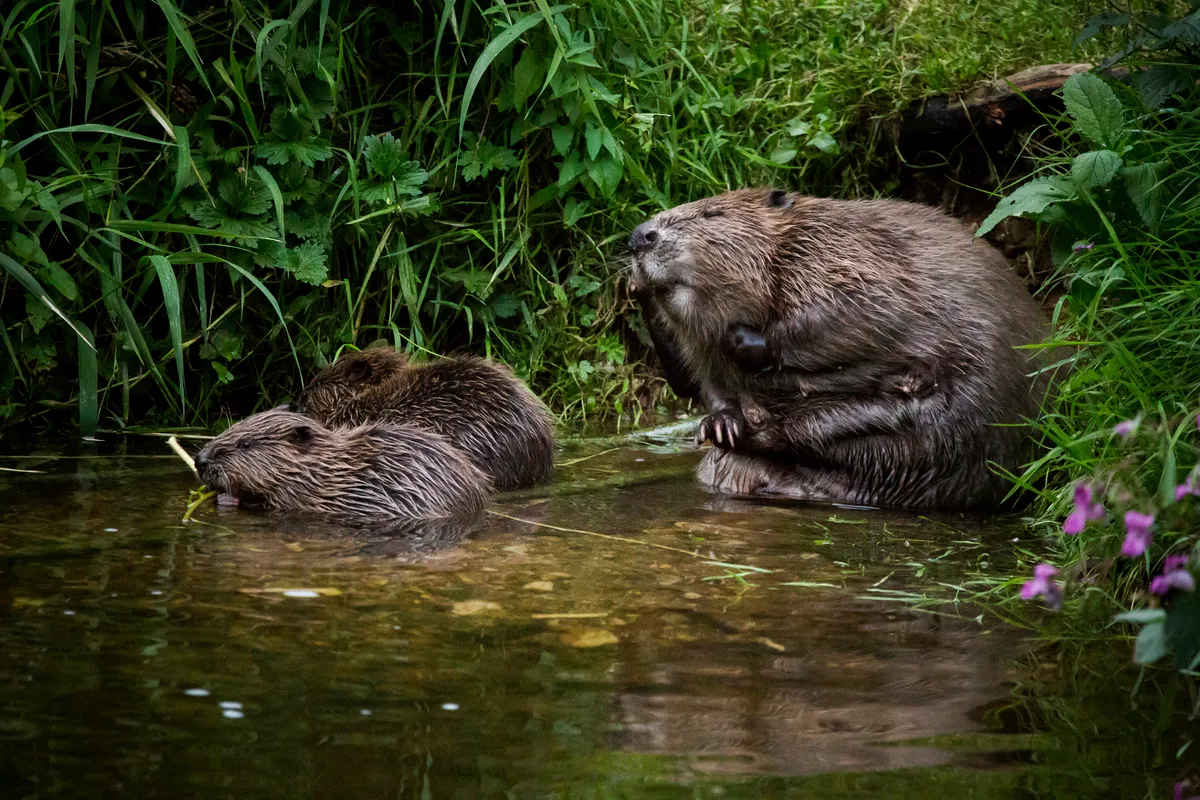Although the idea of life-long pairings is appealing, with sweet pairs of animals mating for life and raising families together, as a mating strategy monogamy is actually very rare in the natural world.
Mating for life only arises in situations where it will improve reproductive success, such as when male as well as female parental care is vital for the survival of offspring. This is why it is so much more common in birds than in other animal groups, as chicks are very small and vulnerable, and as they are incubated outside the body, males are given the chance to pitch in.
- How do birds mate? A guide to bird sex
- True love for zebra finches
- Why promiscuity pays off for female dunnocks
Birds such as penguins, swans, and albatrosses are thus often the first that people go to when thinking of animals that mate for life.
As you will find out, however, even lifelong monogamy in animals doesn’t always equate to sexual exclusivity. Just like humans animals not only break up - “divorcing” after a failed breeding attempt for example - they also have affairs. Genetic analysis has revealed surprises about many previously assumed very “faithful” animals.
Like an animal version of Jeremy Kyle, paternity does not always match up with living arrangements! Read on to find out more.
Here are more things you never knew about animal sex.
What animals mate for life?
Black Vultures (Coragyps atratus)

It seems fitting to begin our list with a bird, as they are the group of animals that show by far the highest level of monogamous mating. Over 90% of bird species form some kind of monogamous pair bond, although this may not be lifelong, and they are not always “faithful”.
Black vultures have a particularly strong monogamous bond, however, staying with their chosen mates all year round and for multiple breeding seasons. Unlike many other bird species, they appear to be very loyal to their mate, with genetic evidence showing that they do not seem to have so-called “extra-pair copulations”. The partnership is sealed with a courtship ritual that involves strutting and head-bobbing.
Shingleback skink (Tiliqua rugosa)

In contrast, the next on our list of animals that mate for life is from a group in which a monogamous reproductive style is extremely rare. In lizards, polygamy (males mating with multiple females) and polyandry (females mating with multiple males) are much more common.
In these skinks however social monogamy - wherein they pair bond and associate with the same long-term partner for many years - is the norm. These relationships have been known to persist for up to 20 years. Social monogamy does not necessarily imply strict sexual monogamy, however, and refers more to living patterns.
Although socially monogamous species may live and raise young together, they do sometimes mate outside this pair, with one study finding that about 20% of the males in their sample mated with more than one female. This social but not strict sexual monogamy is something that these lizards share with others on our list.
Eursian beaver (Castor fiber)

The Eurasian beaver on the other hand is a particularly faithful mate. These rodents live in family groups consisting of a male and female and their offspring. In this case their social monogamy does seem to correspond with sexual monogamy, with young only belonging to bonded pairs.
This is in contrast to North American beavers (Canada's national animal) in which genetic analysis has found that as much of 50% of litters are sired by more than one male, indicating that unlike their Eurasian cousins these female beavers are having sneaky affairs.
Prairie vole (Microtus ochrogaster)
Another very committed rodent species is the prairie vole. These tiny North American natives form lifelong associations wherein males bond to the first female they mate with.
These sweet pairs live together year-round, huddle together, groom each other, and raise pups together. It is thought that this strong pair bond is regulated by a hormone called vasopressin, which makes them more possessive over their mate and caring over their shared brood.
Nevertheless, (and this is becoming a theme) they do still sometimes mate with others. Like the skinks, their social monogamy is strong, but sexual behaviours are not so exclusive
Coppery titi monkey (Callicebus cupreus)

You might think, given their relative prominence on this list, that monogamy in mammals is common. This is not the case however, with only about 3-5% of mammal species showing any form of monogamy. These pair-bonded mammals are very much the exception rather than the rule.
Monogamy is much more common in primates than other clades, however, with these South American monkeys being a good example. Not only do they show all the hallmarks of strong social monogamy - long-term pair bonds, living together outside of mating seasons, and caring for young together - but they also show very high levels of male care and sexual exclusivity. Infants are carried almost exclusively by their father - and genetic studies indicate that he really is their biological parent, with no evidence for mating outside the pair bond.
Coyote (Canis latrans)

One animal that really does seem to stick to the “til death do us part” aspect of mating for life is the coyote. Studies have shown that these canids do not seem to “divorce” at all, only finding a new mate when their partner dies.
They also put a lot of effort into maintaining their monogamous partnership - practising diligent mate guarding. When a female is in oestrus her mate will be continuously by her side and not letting any other males get a look in.
Male canids have good reasons for ensuring that all their pups are their own, as both parents invest a lot into raising their young, and the success of a litter is dependent on both parents cooperating and being involved. And they seemingly do a good job, as unlike other canid species, cheating doesn't seem to occur.
Black-browed albatross (Thalassarche melanophris)

Albatrosses are perhaps the poster child for avian monogamy. Anyone who has watched David Attenborough will have seen these majestic albatross couples solidifying their union with an elaborate courtship dance.
They will typically reunite with the same partner every breeding season for their whole lives. You may be upset to discover however that divorce in these birds is fairly common and increasing.
A 2021 study on black-browed albatross found that not only does divorce happen after breeding failures, rates of divorce are being pushed up by climate change. The authors suggest that warmer waters are forcing the birds to hunt for longer and fly further, causing extra stress, which makes it harder to maintain their relationships.
Dik-dik (Madoqua genus)

These tiny antelopes are thought to exhibit a mating strategy called facultative monogamy, wherein males and females stay together with the same partner due to a lack of other available options, generally because the species exists at a low density. Very romantic!
The male is generally not very committed to the female and provides no parental care to offspring. This is in contrast to obligate monogamy in which breeding success is dependent on both parents providing parental care. Male (but not female) dik-diks will attempt to engage in mating with other females if the opportunity arises. Perhaps contenders for the worst husbands in the animal kingdom?
Atlantic puffin (Fratercula arctica)
Atlantic puffins are committed partners, often staying with the same mate for their whole lives. This is a part-time relationship, however, as they spend a lot of the year living a solitary existence out at sea, coming back together when they return to their nest sites for the breeding season.
It has been suggested that their fidelity is actually to their nesting site, given that they return to the same burrows year after year, and not to their mate per se, but this is hard to know. We do know that they are useful partners to each other, the female providing most but not all of the care to their offspring, and the male playing his part by guarding and maintaining the nest.
Find out about how staying near to each other can increase breeding success in puffins.
White-Handed Gibbons (Hylobates lar)

Gibbons are often seen as the archetype of a harmonious nuclear family - they live in long-term bonded pairs with their offspring and sing together in the morning. This is all a bit too perfect to be true however. Like many of the animals on this list “cheating” and “divorce” are common, with studies on this species revealing a surprising amount of flexibility in their once-thought rigid mating system.
Extra-pair copulations, partner changes, and polyandrous (multiple males for one female) groupings exist alongside the mated-for-life monogamous pairs. It is thought that environmental factors like territory size may have an effect on what the best strategy is for success.
Anglerfish (Lophiiformes)
One of the most unusual examples of monogamy is the deep-sea anglerfish. While females spend their lives hunting, the males (which are smaller and have no luminous lure on their heads) are able to sniff out a future mate in the darkness.
But he's not usually the first one to find her – while the male is sexually monogamous, he'll often share his partner with up to six other males. He'll latch onto the female however, and slowly fuses to her. Even their bloodstreams will eventually connect. The male supplies a constant stream of sperm so the female can fertilise eggs for the rest of her life, ensuring species survival.
More animals facts:

